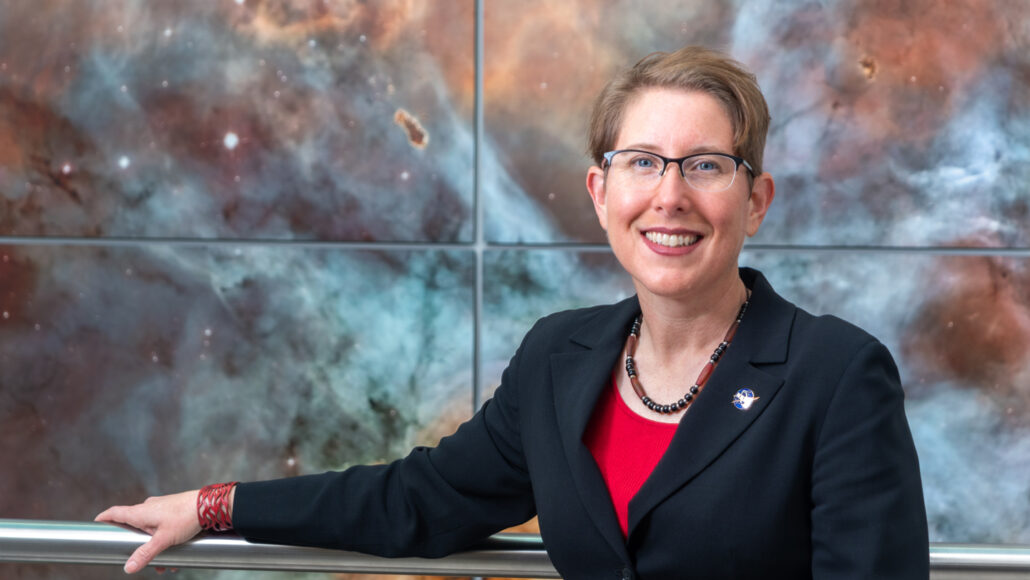One of a telescope operator’s primary jobs is to keep any stray light out of the instrument. Earthly and other unwelcome photons can swamp the cosmic light from distant stars and galaxies. During more than a decade as a project scientist for the James Webb Space Telescope, Jane Rigby obsessed over minimizing light leaks — with extraordinary success. The sky looks darker to JWST than most anyone had hoped.
Rigby herself, now the senior project scientist for JWST, is a source of light.
border: 1px solid #ffcccb;
color: white;
margin-top: 50px;
background-image: url(“/wp-content/themes/sciencenews/client/src/images/[email protected]”);
padding: 20px;
clear: both;
}
.zephr-registration-form{max-width:440px;margin:20px auto;padding:20px;background-color:#fff;font-family:var(–zephr-typography-body-font), var(–zephr-typography-body-fallbackFont)}.zephr-registration-form *{box-sizing:border-box}.zephr-registration-form-text > *{color:var(–zephr-color-text-main)}.zephr-registration-form-relative-container{position:relative}.zephr-registration-form-flex-container{display:flex}.zephr-registration-form-input.svelte-blfh8x{display:block;width:100%;height:calc(var(–zephr-input-height) * 1px);padding-left:8px;font-size:16px;border:calc(var(–zephr-input-borderWidth) * 1px) solid var(–zephr-input-borderColor);border-radius:calc(var(–zephr-input-borderRadius) * 1px);transition:border-color 0.25s ease, box-shadow 0.25s ease;outline:0;color:var(–zephr-color-text-main);background-color:#fff;font-family:var(–zephr-typography-body-font), var(–zephr-typography-body-fallbackFont)}.zephr-registration-form-input.svelte-blfh8x::placeholder{color:var(–zephr-color-background-tinted)}.zephr-registration-form-input-checkbox.svelte-blfh8x{width:auto;height:auto;margin:8px 5px 0 0;float:left}.zephr-registration-form-input-radio.svelte-blfh8x{position:absolute;opacity:0;cursor:pointer;height:0;width:0}.zephr-registration-form-input-color[type=”color”].svelte-blfh8x{width:50px;padding:0;border-radius:50%}.zephr-registration-form-input-color[type=”color”].svelte-blfh8x::-webkit-color-swatch{border:none;border-radius:50%;padding:0}.zephr-registration-form-input-color[type=”color”].svelte-blfh8x::-webkit-color-swatch-wrapper{border:none;border-radius:50%;padding:0}.zephr-registration-form-input.disabled.svelte-blfh8x,.zephr-registration-form-input.disabled.svelte-blfh8x:hover{border:calc(var(–zephr-input-borderWidth) * 1px) solid var(–zephr-input-borderColor);background-color:var(–zephr-color-background-tinted)}.zephr-registration-form-input.error.svelte-blfh8x{border:1px solid var(–zephr-color-warning-main)}.zephr-registration-form-input-label.svelte-1ok5fdj.svelte-1ok5fdj{margin-top:10px;display:block;line-height:30px;font-size:12px;color:var(–zephr-color-text-tinted);font-family:var(–zephr-typography-body-font), var(–zephr-typography-body-fallbackFont)}.zephr-registration-form-input-label.svelte-1ok5fdj span.svelte-1ok5fdj{display:block}.zephr-registration-form-button.svelte-17g75t9{height:calc(var(–zephr-button-height) * 1px);line-height:0;padding:0 20px;text-decoration:none;text-transform:capitalize;text-align:center;border-radius:calc(var(–zephr-button-borderRadius) * 1px);font-size:calc(var(–zephr-button-fontSize) * 1px);font-weight:normal;cursor:pointer;border-style:solid;border-width:calc(var(–zephr-button-borderWidth) * 1px);border-color:var(–zephr-color-action-tinted);transition:backdrop-filter 0.2s, background-color 0.2s;margin-top:20px;display:block;width:100%;background-color:var(–zephr-color-action-main);color:#fff;position:relative;overflow:hidden;font-family:var(–zephr-typography-body-font), var(–zephr-typography-body-fallbackFont)}.zephr-registration-form-button.svelte-17g75t9:hover{background-color:var(–zephr-color-action-tinted);border-color:var(–zephr-color-action-tinted)}.zephr-registration-form-button.svelte-17g75t9:disabled{background-color:var(–zephr-color-background-tinted);border-color:var(–zephr-color-background-tinted)}.zephr-registration-form-button.svelte-17g75t9:disabled:hover{background-color:var(–zephr-color-background-tinted);border-color:var(–zephr-color-background-tinted)}.zephr-registration-form-text.svelte-i1fi5{font-size:19px;text-align:center;margin:20px auto;font-family:var(–zephr-typography-body-font), var(–zephr-typography-body-fallbackFont)}.zephr-registration-form-divider-container.svelte-mk4m8o{display:flex;align-items:center;justify-content:center;margin:40px 0}.zephr-registration-form-divider-line.svelte-mk4m8o{height:1px;width:50%;margin:0 5px;background-color:var(–zephr-color-text-tinted);;}.zephr-registration-form-divider-text.svelte-mk4m8o{margin:0 12px;color:var(–zephr-color-text-main);font-size:14px;font-family:var(–zephr-typography-body-font), var(–zephr-typography-body-fallbackFont);white-space:nowrap}.zephr-registration-form-input-inner-text.svelte-lvlpcn{cursor:pointer;position:absolute;top:50%;transform:translateY(-50%);right:10px;color:var(–zephr-color-text-main);font-size:12px;font-weight:bold;font-family:var(–zephr-typography-body-font), var(–zephr-typography-body-fallbackFont)}.zephr-registration-form-response-message.svelte-179421u{text-align:center;padding:10px 30px;border-radius:5px;font-size:15px;margin-top:10px;font-family:var(–zephr-typography-body-font), var(–zephr-typography-body-fallbackFont)}.zephr-registration-form-response-message-title.svelte-179421u{font-weight:bold;margin-bottom:10px}.zephr-registration-form-response-message-success.svelte-179421u{background-color:#baecbb;border:1px solid #00bc05}.zephr-registration-form-response-message-error.svelte-179421u{background-color:#fcdbec;border:1px solid #d90c00}.zephr-registration-form-social-sign-in.svelte-gp4ky7{align-items:center}.zephr-registration-form-social-sign-in-button.svelte-gp4ky7{height:55px;padding:0 15px;color:#000;background-color:#fff;box-shadow:0px 0px 5px rgba(0, 0, 0, 0.3);border-radius:10px;font-size:17px;display:flex;align-items:center;cursor:pointer;margin-top:20px;font-family:var(–zephr-typography-body-font), var(–zephr-typography-body-fallbackFont)}.zephr-registration-form-social-sign-in-button.svelte-gp4ky7:hover{background-color:#fafafa}.zephr-registration-form-social-sign-in-icon.svelte-gp4ky7{display:flex;justify-content:center;margin-right:30px;width:25px}.zephr-form-link-message.svelte-rt4jae{margin:10px 0 10px 20px;font-family:var(–zephr-typography-body-font), var(–zephr-typography-body-fallbackFont)}.zephr-recaptcha-tcs.svelte-1wyy3bx{margin:20px 0 0 0;font-size:15px;font-family:var(–zephr-typography-body-font), var(–zephr-typography-body-fallbackFont)}.zephr-recaptcha-inline.svelte-1wyy3bx{margin:20px 0 0 0}.zephr-registration-form-progress-bar.svelte-8qyhcl{width:100%;border:0;border-radius:20px;margin-top:10px}.zephr-registration-form-progress-bar.svelte-8qyhcl::-webkit-progress-bar{background-color:var(–zephr-color-background-tinted);border:0;border-radius:20px}.zephr-registration-form-progress-bar.svelte-8qyhcl::-webkit-progress-value{background-color:var(–zephr-color-text-tinted);border:0;border-radius:20px}.zephr-registration-progress-bar-step.svelte-8qyhcl{margin:auto;color:var(–zephr-color-text-tinted);font-size:12px;font-family:var(–zephr-typography-body-font), var(–zephr-typography-body-fallbackFont)}.zephr-registration-progress-bar-step.svelte-8qyhcl:first-child{margin-left:0}.zephr-registration-progress-bar-step.svelte-8qyhcl:last-child{margin-right:0}.zephr-registration-form-input-error-text.svelte-19a73pq{color:var(–zephr-color-warning-main);font-family:var(–zephr-typography-body-font), var(–zephr-typography-body-fallbackFont)}.zephr-registration-form-input-select.svelte-19a73pq{display:block;appearance:auto;width:100%;height:calc(var(–zephr-input-height) * 1px);font-size:16px;border:calc(var(–zephr-input-borderWidth) * 1px) solid var(–zephr-color-text-main);border-radius:calc(var(–zephr-input-borderRadius) * 1px);transition:border-color 0.25s ease, box-shadow 0.25s ease;outline:0;color:var(–zephr-color-text-main);background-color:#fff;padding:10px}.zephr-registration-form-input-select.disabled.svelte-19a73pq{border:1px solid var(–zephr-color-background-tinted)}.zephr-registration-form-input-select.unselected.svelte-19a73pq{color:var(–zephr-color-background-tinted)}.zephr-registration-form-input-select.error.svelte-19a73pq{border-color:var(–zephr-color-warning-main)}.zephr-registration-form-input-textarea.svelte-19a73pq{background-color:#fff;border:1px solid #ddd;color:#222;font-size:14px;font-weight:300;padding:16px;width:100%}.zephr-registration-form-input-slider-output.svelte-19a73pq{margin:13px 0 0 10px}.zephr-registration-form-input-inner-text.svelte-lvlpcn{cursor:pointer;position:absolute;top:50%;transform:translateY(-50%);right:10px;color:var(–zephr-color-text-main);font-size:12px;font-weight:bold;font-family:var(–zephr-typography-body-font), var(–zephr-typography-body-fallbackFont)}.spin.svelte-1cj2gr0{animation:svelte-1cj2gr0-spin 2s 0s infinite linear}.pulse.svelte-1cj2gr0{animation:svelte-1cj2gr0-spin 1s infinite steps(8)}@keyframes svelte-1cj2gr0-spin{0%{transform:rotate(0deg)}100%{transform:rotate(360deg)}}.zephr-registration-form-checkbox.svelte-1gzpw2y{position:absolute;opacity:0;cursor:pointer;height:0;width:0}.zephr-registration-form-checkbox-label.svelte-1gzpw2y{display:flex;align-items:center;font-family:var(–zephr-typography-body-font), var(–zephr-typography-body-fallbackFont)}.zephr-registration-form-checkmark.svelte-1gzpw2y{position:relative;box-sizing:border-box;height:23px;width:23px;background-color:#fff;border:1px solid var(–zephr-color-text-main);border-radius:6px;margin-right:12px;cursor:pointer}.zephr-registration-form-checkmark.checked.svelte-1gzpw2y{border-color:#009fe3}.zephr-registration-form-checkmark.checked.svelte-1gzpw2y:after{content:””;position:absolute;width:6px;height:13px;border:solid #009fe3;border-width:0 2px 2px 0;transform:rotate(45deg);top:3px;left:8px;box-sizing:border-box}.zephr-registration-form-checkmark.disabled.svelte-1gzpw2y{border:1px solid var(–zephr-color-background-tinted)}.zephr-registration-form-checkmark.disabled.checked.svelte-1gzpw2y:after{border:solid var(–zephr-color-background-tinted);border-width:0 2px 2px 0}.zephr-registration-form-checkmark.error.svelte-1gzpw2y{border:1px solid var(–zephr-color-warning-main)}.zephr-registration-form-input-radio.svelte-1qn5n0t{position:absolute;opacity:0;cursor:pointer;height:0;width:0}.zephr-registration-form-radio-label.svelte-1qn5n0t{display:flex;align-items:center;font-family:var(–zephr-typography-body-font), var(–zephr-typography-body-fallbackFont)}.zephr-registration-form-radio-dot.svelte-1qn5n0t{position:relative;box-sizing:border-box;height:23px;width:23px;background-color:#fff;border:1px solid #ebebeb;border-radius:50%;margin-right:12px}.checked.svelte-1qn5n0t{border-color:#009fe3}.checked.svelte-1qn5n0t:after{content:””;position:absolute;width:17px;height:17px;background:#009fe3;background:linear-gradient(#009fe3, #006cb5);border-radius:50%;top:2px;left:2px}.disabled.checked.svelte-1qn5n0t:after{background:var(–zephr-color-background-tinted)}.error.svelte-1qn5n0t{border:1px solid var(–zephr-color-warning-main)}.zephr-form-link.svelte-64wplc{margin:10px 0;color:#6ba5e9;text-decoration:underline;cursor:pointer;font-family:var(–zephr-typography-body-font), var(–zephr-typography-body-fallbackFont)}.zephr-form-link-disabled.svelte-64wplc{color:var(–zephr-color-text-main);cursor:none;text-decoration:none}.zephr-registration-form-google-icon.svelte-1jnblvg{width:20px}.zephr-registration-form-password-progress.svelte-d1zv9r{display:flex;margin-top:10px}.zephr-registration-form-password-bar.svelte-d1zv9r{width:100%;height:4px;border-radius:2px}.zephr-registration-form-password-bar.svelte-d1zv9r:not(:first-child){margin-left:8px}.zephr-registration-form-password-requirements.svelte-d1zv9r{margin:20px 0;justify-content:center}.zephr-registration-form-password-requirement.svelte-d1zv9r{display:flex;align-items:center;color:var(–zephr-color-text-tinted);font-size:12px;height:20px;font-family:var(–zephr-typography-body-font), var(–zephr-typography-body-fallbackFont)}.zephr-registration-form-password-requirement-icon.svelte-d1zv9r{margin-right:10px;font-size:15px}.zephr-registration-form-password-progress.svelte-d1zv9r{display:flex;margin-top:10px}.zephr-registration-form-password-bar.svelte-d1zv9r{width:100%;height:4px;border-radius:2px}.zephr-registration-form-password-bar.svelte-d1zv9r:not(:first-child){margin-left:8px}.zephr-registration-form-password-requirements.svelte-d1zv9r{margin:20px 0;justify-content:center}.zephr-registration-form-password-requirement.svelte-d1zv9r{display:flex;align-items:center;color:var(–zephr-color-text-tinted);font-size:12px;height:20px;font-family:var(–zephr-typography-body-font), var(–zephr-typography-body-fallbackFont)}.zephr-registration-form-password-requirement-icon.svelte-d1zv9r{margin-right:10px;font-size:15px}.zephr-registration-form {
max-width: 100%;
background-image: url(https://www.sciencenews.org/wp-content/uploads/2023/05/newsletter-signup-background_REV.jpg);
background-position: top 75% left 67%;
font-family: var(–zephr-typography-body-font), var(–zephr-typography-body-fallbackFont);
margin: 0px auto;
margin-bottom: 4rem;
padding: 20px;
}
.zephr-registration-form-text.svelte-i1fi5 p {
padding-left: 10px;
padding-right: 10px;
padding-bottom: 10px;
}
.zephr-registration-form-text.svelte-i1fi5 h2 {
padding-top: 10px;
}
.zephr-registration-form-text h6 {
font-size: 0.8rem;
}
.zephr-registration-form h4 {
font-size: 3rem;
}
.zephr-registration-form h4 {
font-size: 1.5rem;
}
.zephr-registration-form-button.svelte-17g75t9:hover {
background-color: #fc6a65;
border-color: #fc6a65;
width: 150px;
margin-left: auto;
margin-right: auto;
}
.zephr-registration-form-button.svelte-17g75t9:disabled {
background-color: #e04821;
border-color: #e04821;
width: 150px;
margin-left: auto;
margin-right: auto;
}
.zephr-registration-form-button.svelte-17g75t9 {
background-color: #e04821;
border-color: #e04821;
width: 150px;
margin-left: auto;
margin-right: auto;
}
.zephr-registration-form-text > * {
color: #FFFFFF;
font-weight: bold
font: 25px;
background-color: rgba(10,10,10,0.7)
}
.zephr-registration-form-progress-bar.svelte-8qyhcl {
width: 100%;
border: 0;
border-radius: 20px;
margin-top: 10px;
display: none;
}
.zephr-registration-form-response-message-title.svelte-179421u {
font-weight: bold;
margin-bottom: 10px;
display: none;
}
.zephr-registration-form-response-message-success.svelte-179421u {
background-color: #8db869;
border: 1px solid #8db869;
color: white;
margin-top: -0.2rem;
}
.zephr-registration-form-text.svelte-i1fi5:nth-child(1){
font-size: 18px;
text-align: center;
margin: 20px auto;
font-family: var(–zephr-typography-body-font), var(–zephr-typography-body-fallbackFont);
color: white;
}
.zephr-registration-form-text.svelte-i1fi5:nth-child(5){
font-size: 18px;
text-align: left;
margin: 20px auto;
font-family: var(–zephr-typography-body-font), var(–zephr-typography-body-fallbackFont);
color: white;
}
.zephr-registration-form-text.svelte-i1fi5:nth-child(7){
font-size: 18px;
text-align: left;
margin: 20px auto;
font-family: var(–zephr-typography-body-font), var(–zephr-typography-body-fallbackFont);
color: white;
}
.zephr-registration-form-text.svelte-i1fi5:nth-child(9){
font-size: 18px;
text-align: left;
margin: 20px auto;
font-family: var(–zephr-typography-body-font), var(–zephr-typography-body-fallbackFont);
color: white;
}
.zephr-registration-form-input-label.svelte-1ok5fdj span.svelte-1ok5fdj {
display: none;
color: white;
}
.zephr-registration-form-input.disabled.svelte-blfh8x, .zephr-registration-form-input.disabled.svelte-blfh8x:hover {
border: calc(var(–zephr-input-borderWidth) * 1px) solid var(–zephr-input-borderColor);
background-color: white;
}
.zephr-registration-form-checkbox-label.svelte-1gzpw2y {
display: flex;
align-items: center;
font-family: var(–zephr-typography-body-font), var(–zephr-typography-body-fallbackFont);
color: white;
font-size: 20px;
margin-bottom: -20px;
}
.zephr-registration-progress-bar-step.svelte-8qyhcl:first-child {
display: none;
}
.zephr-registration-progress-bar-step.svelte-8qyhcl:last-child {
display: none;
}
“I remember the light in her eyes,” says astrophysicist Jane Charlton, who met Rigby the summer before her freshman year at Penn State and later advised her research. “Jane had incredible grades, but that’s not necessarily what I look for. The love of astronomy, and passion for that, is what I look for.”
Nearly three decades later, Rigby’s palpable joy in discussing the success of JWST, which launched on December 25, 2021, has made her one of the public faces of the telescope. She presented the telescope’s first images at the White House and has given keynote speeches at some of the biggest astronomy meetings (SN: 8/13/22, p. 30). During public appearances, she often wears JWST-themed socks, scarves and pins. “I have JWST socks for pretty much every day of the week,” she says.
She has also lit a path for queer astronomers, as well as others who are historically underrepresented in astronomy. Rigby has been out as part of the LGBTQ+ community since 2000, when she met her now-wife when they were both astronomy graduate students at the University of Arizona in Tucson. She has devoted much of her career to holding the door open for others.
“I didn’t grow up with any queer role models,” she says. “I hope I’m the last generation for which that’s true.”
Focusing on the instruments
Rigby remembers being asked to draw a favorite TV show in preschool. She used up an entire black crayon drawing Carl Sagan’s Cosmos.
Her interest in space crystallized into a career plan at about age 12, after she saw Sally Ride speak at a local college. Ride, the first American woman in space, made Rigby want to be an astronaut.
“I knew there were two paths to becoming an astronaut: a test pilot or a scientist,” she says. “And it was pretty clear that I was never going to be tall enough to fly the shuttle.” At 5 feet, 2 inches tall, she’s still two inches too short to have been a space shuttle pilot. If she couldn’t make it to space, she saw more potential in science than in flying planes.
Rigby’s first experience using a telescope for research, as an undergraduate student at Penn State, was stymied by light leaks. She, Charlton and another student traveled to western Texas to use the telescope at the McDonald Observatory. They were looking to catch light from a distant quasar filtering through a diffuse and mysterious cloud of cosmic gas. These small, dense clouds appear to be packed with heavy elements from supernova explosions, but surprisingly, they’re not found in galaxies’ centers where a lot of stars are born and dying. “We were, at that time, trying to figure out what they were,” Charlton says. “As we still are.”
After a night of guiding the telescope by hand, the group realized that light from something other than the quasar — maybe an alert light on an instrument panel — had flooded the telescope. The trio tracked it down, covered it with tape and tried again. The same thing happened night after night. Ultimately, they returned to Pennsylvania with no quasar data.
“It didn’t work,” Rigby says. “But it was really fun. I was learning everything, trying to learn how the telescope worked.”
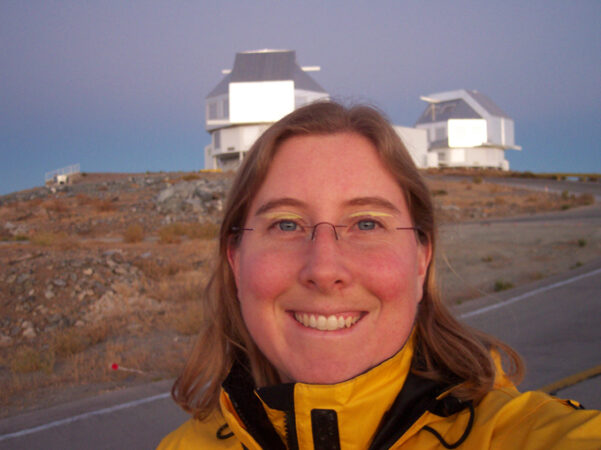
Since then, Rigby has used many major telescopes, from those at the Keck Observatory in Hawaii to the Magellan telescopes in Chile to the Spitzer and Hubble space telescopes. Along the way, her research developed a theme: investigating how galaxies grow and change along with the supermassive black holes hiding within.
But her approach is less “How can I answer this burning question?” and more “What can I do with this shiny new instrument?”
color: black;
margin-top: 0px;
background-image: url(“”);
background-size: cover;
padding: 20px;
border: 1px solid #ffcccb;
border-top: 5px solid #e04821;
clear: both;
}
“I’m a very observational astronomer,” she says. “I will use any telescope I can get my hands on.”
All that telescope time meant she was ready to join the JWST team when the opportunity came.
“Because she had seen data from Spitzer and Hubble,” JWST’s precursors, says astronomer Matt Mountain of the Association of Universities for Research in Astronomy in Washington, D.C., “she knew what she was looking for.”
Meeting the James Webb Space Telescope
Rigby began working on JWST in 2010, when she took a job at NASA’s Goddard Space Flight Center in Greenbelt, Md., as the telescope’s deputy operations project scientist.
One of the first things she did was read the report of an independent review panel that found that the telescope was mismanaged, over budget by billions of dollars and would launch years later than originally planned (SN: 11/11/10). “I’ve certainly been four years from launch multiple times,” she says.
Before launch, most of her time was devoted to making sure that changes to the telescope’s design wouldn’t mess up the science. She imagined possible ways to use JWST and met with other team members to make sure the final telescope would deliver on those goals. Would the telescope materials glow or release gases that could freeze to the machine? Could JWST use two cameras simultaneously? Could it study moving targets, like asteroids within the solar system (SN: 11/5/22, p. 14)?
“Because she is a working scientist who really wanted to use the data,” Mountain says, “she was an ideal choice for operations scientist,” a job she moved up to in 2018. “In these complex spaces, with all the engineering, the personalities, the politics at NASA, working with contractors, she always keeps her eye on the prize: What science are we trying to do?”
Rigby bridged the divide between the science and engineering teams, helping them speak a common language. Her job has been “a lot of active listening and soft power, a lot of synthesizing and a dose of specialized technical expertise,” she says. “Oftentimes I’m the big-picture person in a room full of specialists.”
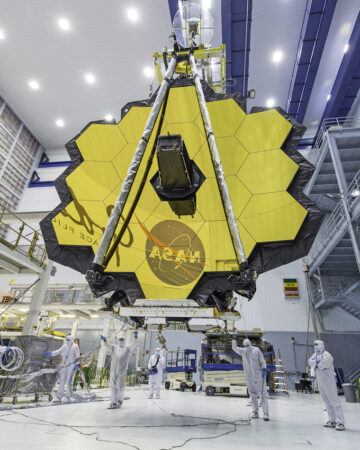
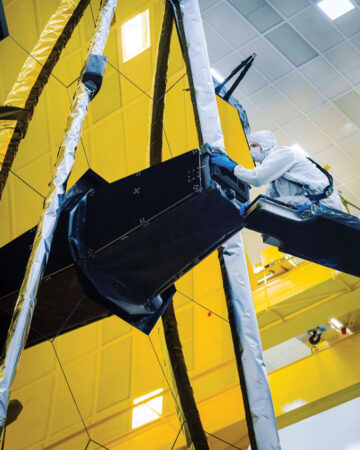
After the telescope launched, got in position and unfolded itself — “the six-month unwrapping of the Christmas present,” Rigby says — her job shifted to characterizing how well the telescope works. In practically every metric, it’s a dream come true.
There’s better-than-expected image quality, higher sensitivity, faster response times and a longer potential mission lifetime than predicted before launch — and practically no light leaks. The telescope’s great golden mirrors are exposed to space, and light can scatter off dust grains on the mirrors, registering on images as faint, diffuse patterns the team calls “wisps” and “claws,” or a ghostly streak dubbed “the lightsaber.” But the mirrors proved remarkably dust-free, meaning the sky appears incredibly dark.
“It’s not an accident that the telescope works so well,” she says. “That was careful work beforehand.”
When asked about such successes, and her own, Rigby points to a huge amount of work by tens of thousands of people. “I understand the desire to humanize something that can seem really big and impersonal. But I don’t like the singling out,” she says. “I try to reflect it back to the team.” It took thousands of people and tasks to ensure JWST’s success. Engineer Larkin Carey, with Ball Aerospace, for example, cleaned every square centimeter of the telescope’s mirrors by hand with a tool like a shaving brush, Rigby says.
With the telescope working so well, Rigby could turn her attention to the scientific questions. She helps lead an observing program called TEMPLATES, looking at galaxies whose light has been magnified by foreground objects to get a glimpse at how the galaxies form stars. At a June meeting in Albuquerque of the American Astronomical Society, Rigby shared how the TEMPLATES team found hydrocarbons, “the same stuff that smoke is made of,” in a galaxy whose light dates back more than 12 billion years — the furthest back in time such molecules had ever been seen.
Early in July, Rigby became the senior project scientist for JWST; it’s her job to figure out how to get the most and best science out of the telescope.
Research colleagues describe her as superhuman. “I don’t know how she does everything that she does, and does everything well,” says TEMPLATES collaborator Keren Sharon of the University of Michigan in Ann Arbor. And Rigby’s enthusiasm is abundant: “She gets giddy,” Sharon says. “It could be about figuring out a bug, or discovering this super exciting thing about a galaxy that we didn’t know before … and she’s literally bouncing. Her face lights up.”
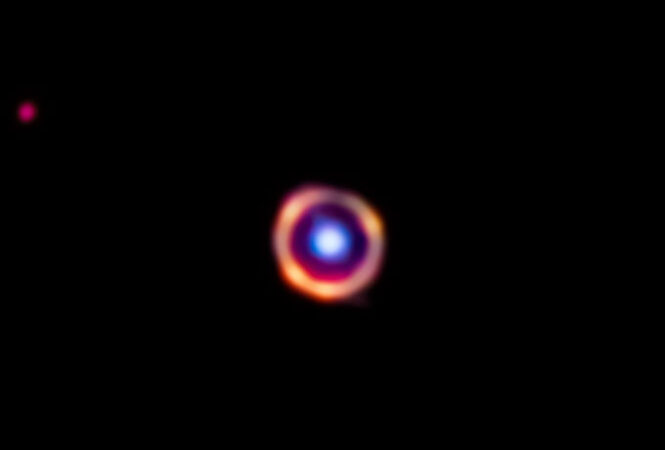
Opening doors for others
Rigby wants anyone to be able to experience and pursue that enthusiasm. When she started attending American Astronomical Society meetings in the 1990s, she didn’t know there was a secret LGBTQ+ networking dinner. “You had to know it existed. That was a little closety. But it’s where people were.”
At the time, there was a lack of protection from employment discrimination and no guarantee of institutional support for astronomers with same-sex partners. Rigby recalls accepting a fellowship at Carnegie Observatories in Pasadena, Calif., and immediately having to request health insurance benefits to cover her partner.
“That’s awkward,” she says. “You want to be talking about your science and your telescope proposals, not how can I get health insurance for my family because we’re different.” Finding other LGBTQ+ astronomers was “a lifeline,” she says.
These days, the meet-up at AAS is too big to go out to dinner. At a January 2023 meeting in Seattle, “we lost count at 120 people. We had to spill out into the hallway,” Rigby says. “That feels good.”
Seeing queer astronomers like Rigby so far along in their careers was helpful to Traci Johnson, a data scientist who was a graduate student in astronomy in Sharon’s lab at the University of Michigan. Johnson identifies as lesbian and nonbinary and came out during graduate school. “I realized it is possible to be out, and be happy, and also have a really amazing career,” Johnson says.
Rigby has taken an active role in encouraging inclusivity, though she seems to be up against the legacy of JWST’s namesake. Many astronomers have called for the telescope to be renamed because James Webb was NASA administrator at a time when the U.S. government fired employees for being gay.
Rigby won’t comment on the telescope’s name. But her support for LGBTQ+ astronomers is clear. Rigby was a founding member of the AAS Committee for Sexual-Orientation and Gender Minorities in Astronomy, which works to promote equality for LGBTQ+ astronomers within the field; has co-organized conferences on making astronomy more inclusive; and authored a recent white paper urging the astronomy community to address diversity, inclusion and harassment. A current priority is making sure trans people feel safe and welcome.
Rigby doesn’t want to be pigeonholed as “the gay astronomer.” She knows her contributions to astronomy extend far beyond any particular group. But she says the leadership skills, resilience and ability to shift her perspective that she has learned through living and organizing as a member of the LGBTQ+ community have made her a better astronomer. They’re skills she transfers to her role as a leader at NASA.
“The whole vision is, you get to bring your authentic self to work,” she says. “And work embraces your authentic self.”


